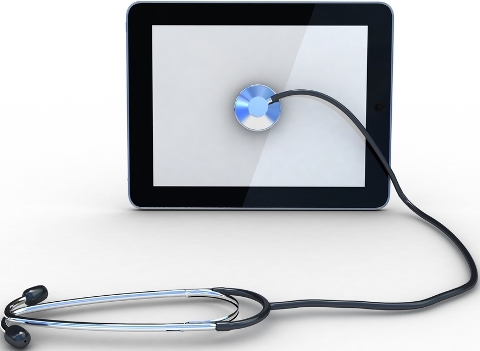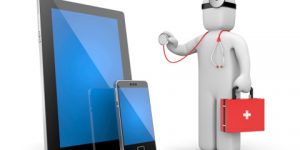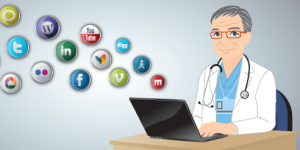ICTpost mHealth Bureau

E-health or electronic health can be defined as the use of ICT for enhancing health and seeking information while mobile health (M-health) can de defined as the use of mobile technology for health related purposes. E-health can mean creating electronic versions of patient records across a national system while M-health can serve as access points to provide remote information to healthcare providers. In developing countries, these technologies find a wide array of applications that include remote data collection and monitoring, disease and epidemic tracking and diagnostic and treatment support amongst others.
Some of the key trends in online and mobile healthcare include the following.
Databases
With the increasing aging population and healthcare requirements in rural areas, technological advancements have led to the development of databases that provide ready to use healthcare information. These databases provide information on pivotal clinical studies, development in disease management to the physicians while few others provide A-Z information regarding diseases, health and drugs to patients. Examples of these include WebMD and Epocrates Rx.
Infrastructure Based Solutions
Telemetry: This refers to the use of a wireless technology that is used to monitor patients with the use of radio waves. However, the usage of this technology has some guidelines in order to prevent the interference of other radio waves with telemetry signals as this can be hazardous to the life of the patient. A recent development in the area of wireless patient monitoring has been the introduction of the GE CARESCAPE Telemetry Platform that is capable of simultaneously leveraging and coordinating cell phone, Wi-Fi and other wireless technologies on a single platform.
Bluetooth: These are user-friendly networks for communicating through cellular phones, PCs and personal digital assistants and falls under the wireless personal area network (WPAN). This technology is low-priced, consumes lesser power and is all set to replace the currently existing forms of wired connectivity.
WiFi: Wireless fidelity (WiFi) is yet another revolutionary technology that has been in use to boost efficiency and enhance care in hospitals. These wireless networks provide secure infrastructure and flexible access than wired solutions.
RFID:?Radio Frequency Identification (RFID) is an enabling technology that uses radio frequency waves to monitor tagged objects and personnel. The principal components of the system include the RFID tags and the reader apart from the software that is being used. RFID has been used both in pharmaceutical industries and hospitals. RFID covers a wide array of applications in healthcare ranging from tracking medical devices such as pacemakers and defibrillators to monitoring patient safety and quality assurance applications.
Software Applications and Devices
Software applications are an integral part of the hospital environment that can assist the healthcare providers with their point of care applications.
Palm OS: This typically represents an operating system that has a touch screen graphical user interface. The wide range of applications in the system along with ease of use and lower memory requirements has been considerably gaining importance across the healthcare industry over the past few years.
Pocket PCs: Microsoft first developed an operating system for hand-held devices which was very similar to the well known Windows version. This was known as Windows CE. However, these require larger storage capacities when compared to Palm OS and hence are less preferred as opposed to the easy to use Palm systems in healthcare.
Laptops: These are similar to the desktop PCs in terms of functions and appearance. However, these are easily transportable in a hospital environment and if connected with a WLAN, can enhance functionalities in both administrative and patient care environments.
Tablet PCs: This is a relatively newer development and carries the same function as a laptop but is equipped with a touch screen and a pen based capability. This enables the user to directly write prescriptions instead of the more tedious process of printing the entire document and later writing on it. Microsoft again has been a major provider of tablet PCs.
Key Technology Adoption Trends
Increased R&D Spending in Pharmaceutical Industries
A considerable amount of investment in pharmaceutical industries goes into drug discovery and development. Although several drugs are being developed, only a few get into the market while others still remain at the research and development phase. Implementing wireless applications into these stages of clinical R&D could significantly reduce time up to 30 percent whilst also saving costs.
Increased usage of EMR/EHR
Realizing the benefits of wireless technologies, several healthcare providers are resorting to using Electronic medical records (EMR) and Electronic Health records (EHR). The e-prescription and Electronic Medical Record (EMR) markets are estimated to reach $300 million in 2021.
Reduced Administrative Burden
Wireless and online technologies considerably reduce burden on nurses and therapists. Technologies such as PDAs (Personal Digital Assistant), smart phones and Ultra-Mobile PC (UMPC) can also aid in patient-centric healthcare by providing details of patients including clinical histories, lab reports, ongoing and past treatments and so on.
Opportunities for Online and Mobile Healthcare in Asia Pacific Asia Pacific has been characterized as a region that has significantly low
quality healthcare when compared to the Western World. There are opportunities galore in the aforementioned areas due to the deprivation of quality health to those in the underprivileged areas.
- The introduction of web cameras and internet in rural areas along with other mobile technologies can aid in extending health services in these areas.
- Another area would be to improve healthcare surveillance in rural areas. With the advent of mobile technology in the rural areas, efforts can be taken to provide realtime monitoring of health related issues. SMS alerts can be used to target people in areas where clinics and healthcare workers are limited.
- Data collection is yet another area that is of vital importance in healthcare. Data collection programs can be offered through smart phones, mobile phones and PDAs than manual entry which can contribute to bridging the gap that exists in the current scenario.
- Implementation of remote monitoring applications can improve the outcome of various chronic diseases whilst also opening newer avenues of treating patients in an outpatient setting.
- Usage of mobile phones can also be helpful in improving communication amongst the healthcare providers to enhance patient care. This can also be used to monitor the incidence and outbreak of infectious diseases.
- The use of mobile phones as a point-of-care device can enable patients to receive diagnosis and treatment assistance at their homes and villages itself thereby averting expensive hospital visits.







